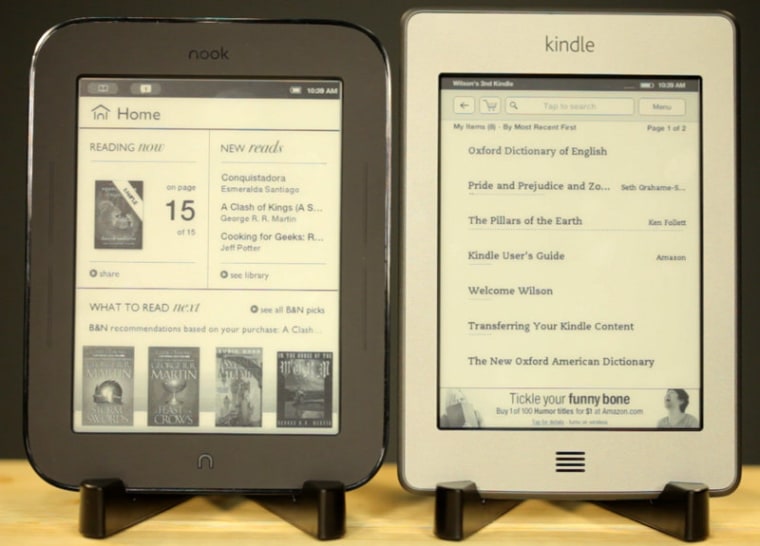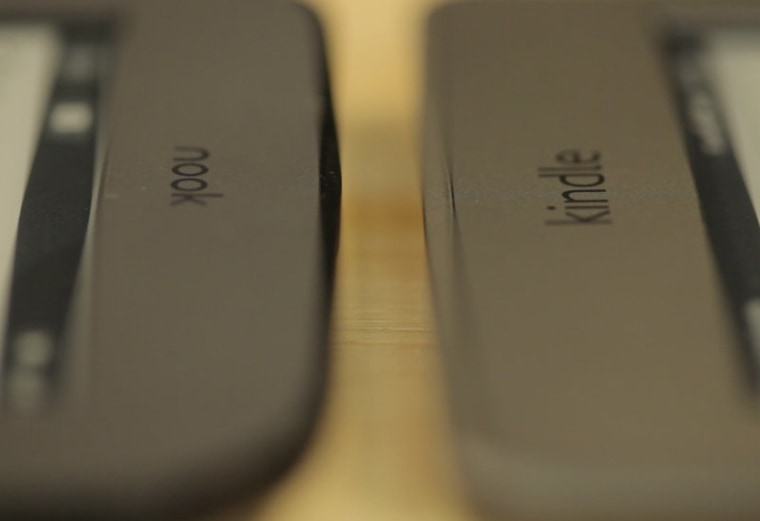Before there was a Kindle Fire or a Nook Tablet, there were e-ink readers, humble slates that showed black words on a white (or nearly white) background, easy on the eyes, the way our ancestors intended. This week, the e-ink readers from Amazon and Barnes & Noble get the power of touch, and the even greater power of a $99 price tag. But which one's better?
Spoiler alert! The B&N Nook Simple Touch and the Amazon Kindle Touch are basically the same.
They have the same screen size, the same contrast, the same speed of page turns. Both can hold 1,000 books or more, though I would be impressed if you ever used more than 5 percent of the capacity. Why? Because both companies keep track of books you buy, and let you reload them in seconds anytime you like. The battery on the Nook Simple Touch lasts "over two months" while the battery on the Amazon Kindle Touch lasts "up to two months." In other words, it's the same!
And besides the fact that they're substantially cheaper in price, these e-ink devices have their benefits. They're as light as paperbacks, are easy to read outside or inside, and can be forgotten for days with no charging, and still be ready for your reading pleasure. Both let you borrow books from libraries and friends, both have social components so you can upload passages to Facebook, and both let you make notes that sync to the cloud, so you can check them later from any device.
The downside is that they need a light source — be it bedside lamp, Itty Bitty Book Light or flickering torch on the wall of your stony keep. There's no color e-ink option, or any way to watch video. Increasingly, cookbooks and kids' books have extra content intended for full-color LCD screens, and these books usually won't even open on e-ink readers.
Whichever e-reader you choose is likely to deliver the same amount of happiness, but there are subtleties, both in the way the devices behave, and in the way their companies manage content, that are worth you knowing before you plunk down your hard-earned Benjamin.

What you'll like about Amazon Kindle Touch:
Amazon's big push right now is for people to sign up for its $80-per-year Prime service. One of the perks is borrowing a book a month from its "Kindle Owners' Lending Library," which includes top-selling titles that you can read at no additional charge, but only if you own a Kindle. Users of the Kindle apps don't get a piece of this action.
While the Kindle Touch lists for $99, you can spend $50 more for a 3G version, which can sync your books anywhere in the world with no fees or contracts. Not only is that nice to have if you're traveling, it's also a key benefit for the older readers, who like the big font sizes of e-readers, but don't have homes equipped with Wi-Fi.
The Kindle Touch supports a lot of mainstream file formats, including PDF, TXT, Word docs (both .doc and .docx) and even HTML pages. (It does not support the ePub format used by many other readers, however.)
Kindle X-Ray is a system that breaks down books to the "bones," key passages, plot shifts, historical references and character appearances, using cloud computing and a combination of community-powered encyclopedias Shelfari, for literature, and Wikipedia, for general subjects. I don't know yet if it's a reader's aid or the 21st century equivalent of Cliff's Notes, but either way, it seems compelling.
Amazon still has an "Experimental" section that includes a Web browser, MP3 player and text-to-speech, where permitted, for reading books out loud.
What you won't like about it:
The way Amazon got its price down is by loading "special offers," that is, "advertisements," onto the sleep screen and home screen of the Kindle. If you want to buy the same device without these ads, you have to pay $30 extra. It's not that annoying to me, and these really are offers you can act on to save money, but many people justifiably bristle at it.
A bit more offensive to me is the Kindle e-ink interface. The Kindle Fire tablet has a simple, smooth interface, so it's hard to get lost. By contrast, on the Kindle Touch, it's easy to get lost on its home page. You can organize your books into collections, but it's still a bit cluttered, and though the touch interaction works, the system was not redesigned to make your finger feel at home.
What you'll like about the B&N Nook Simple Touch:
On interface, Barnes & Noble wins. The home screen is more graphical, and the home button lets you jump from there library, shop, search and settings with a quick tap. Even the pages with a lot of text are a bit cleaner, and there are no ads. To top it off, the Nook Simple Touch has forward and back buttons on each side, and a slightly contoured back panel for better gripping, so it's easier to use one-handed.
Obviously, Amazon is an online powerhouse while Barnes & Noble is more ubiquitous in the big-box malls, so B&N capitalizes on the in-store experience. If you don't have Wi-Fi, you can still pop down to the store to hop on Wi-Fi for free, and download books. (You can also get free Wi-Fi from AT&T hotspots, nationwide.) You can read books that you didn't pay for when you're in the store, so theoretically you could get a bunch of books for free, if you spend enough time in the B&N cafe. And speaking of free, B&N has in-store freebies for Nook owners, and regularly sends emails for free book offers, too.
If you happen to be someone who bought books from other services that support the Adobe Reader rights management software for the ePub file format, then you can use those books with the Nook Simple Touch. (And if you don't know what I'm talking about, this probably doesn't apply to you.)
What you won't like about it:
You'll have to rely on Wi-Fi (whether at home, in the store or somewhere else), since there's no 3G option for the Nook Simple Touch.
Though the Nook Simple Touch does support the widely accepted ePub and PDF formats, it can't load Word or TXT documents you might want to see on it.
There are no frills, such as the Web browser or text-to-speech, so travelers, early adopters and people with special needs may find the Nook lacking.
The bigger picture
It's safe to say that, point by point, I favor the Nook Simple Touch, but the differences that I highlight are far outweighed by the similarities I discussed up top. And the biggest competitive tensions are still there: If you buy books from Barnes & Noble, you can't read them on a Kindle, and if you buy books from Amazon, you can't read them on a Nook. (Not, at least, without some serious hackery.)
And as for those other e-readers you may have heard about, from Sony, or Kobo, or some no-name brand, do yourself a favor and avoid them. There are major benefits in sticking with one of the key players, not least of all the apps that these companies have for iPhone, iPad and Android, that let you keep books synced across devices. And with pricing of Amazon and Barnes & Noble touch-sensitive e-ink devices down below $100, there is absolutely no monetary benefit you can gain by straying from the two leaders.
That's why my best advice to you is to pick a company and stick with it. Do you shop at Barnes & Noble a lot? If so, go with a Nook. Do you belong to Amazon Prime? If so, check out Kindle.
More hot Nook and Kindle action from msnbc.com:
- Tablet war 2011: Nook vs. Kindle vs. iPad
- Q&A: Kindle Fire vs. Nook Tablet vs. iPad
- Kindle Fire review: Yes, it's that good
- Kindle Fire success is Google Android failure
Catch up with Wilson on Twitter at @wjrothman, or on Google+. And join our conversation on Facebook.
